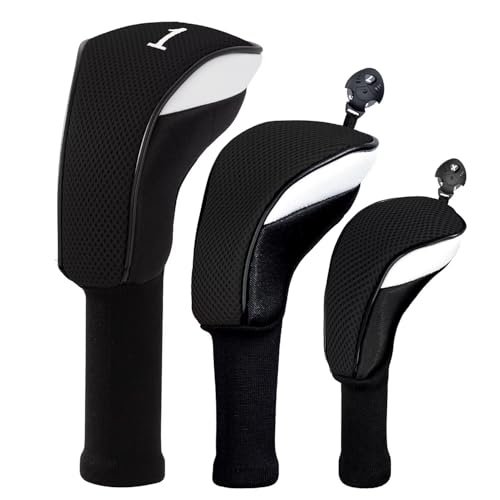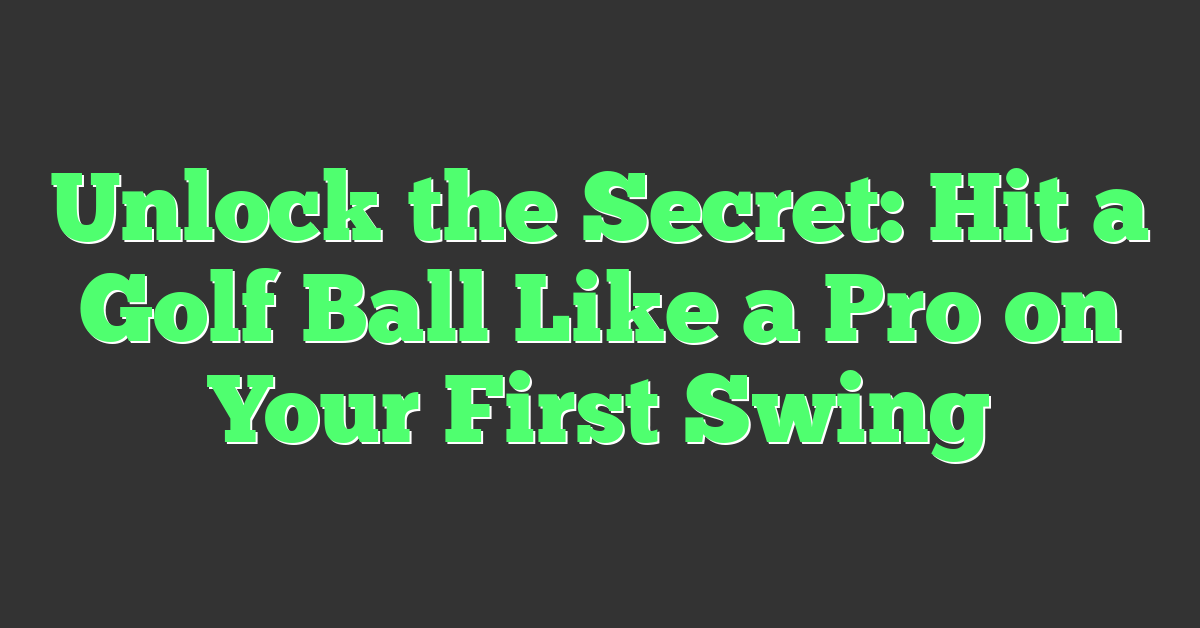Ever wondered why some golf balls seem to soar through the air, defying gravity a tad longer than others? It’s not just your swing that’s making the magic happen. The secret lies in the golf ball you’re teeing up with.

Choosing the right golf ball can be a game-changer, especially when you’re aiming to add those extra yards to your drive. Let’s dive into the nitty-gritty of what makes certain golf balls travel farther and how you can leverage this to shave strokes off your game.
The Role of Golf Ball in Distance
When you’re aiming to shave strokes off your game, understanding the type of golf ball you use can be a game-changer. Think of your golf ball as your trusted companion on the course—one that can either help you reach new distances or hold you back if you’re not paired correctly.
Golf balls vary in construction, and each type has its role in influencing distance. Two-piece golf balls are typically engineered for maximum distance. They have a solid rubber core and a durable outer cover. The firm core’s reaction to your club’s impact is what propels the ball far and fast. If you’re after sheer distance and a lower spinning ball, these are likely your best bet.
On the other end of the spectrum are multi-layered golf balls. Designed for more skilled players, these balls have additional layers or “mantles” that create more spin and control around the greens. They might not always travel the furthest off the tee, but they can provide better shot-shaping capabilities and a softer feel, which could lead to more birdie opportunities.
Did you know the dimple pattern on a golf ball also influences distance? It’s all about aerodynamics—a smooth ball would falter in the air, but those dimples create a thin layer of air around the ball to reduce drag. Manufacturers have rigorously tested various dimple patterns to find the perfect balance that allows the golf ball to travel far while maintaining stability in flight.
Here’s the takeaway: to maximize distance, choose a ball that complements your swing speed and style of play. Have you been playing with a ball that’s suited to your game? If not, it might be time to experiment with a few different types to see which helps add those extra yards. Remember, what works for one player doesn’t necessarily work for another, so don’t shy away from a bit of trial and error.
Choosing the right golf ball is an essential part of improving your game. Next time you’re out on the course, pay close attention to how different balls perform for you—it’s one of the simplest adjustments you can make for potentially significant results. Keep this in mind as you practice, and you’ll be set to make those long drives count.
Understanding Compression and Distance
When you’re teeing up, the golf ball in your hand might just be your secret weapon. Golf ball compression is a term that often gets tossed around, but its impact on distance is crucial. In layman’s terms, compression refers to the density of your golf ball, which directly affects how it reacts when struck by a club. Low compression balls are softer, and high compression balls are harder.
Here’s the science behind it: On impact, the golf ball compresses, storing the energy exerted by your swing. Then, it springs back to its original shape, and this rebound is what launches the ball into flight. The key is finding the right level of compression that matches your swing speed. If you have a faster swing, a high compression ball is ideal, as it’ll maximize the energy return and rocket your ball down the fairway. Conversely, slower swings pair better with low compression balls, which require less force to deform and spring back.
For those of you consistently hitting the ball with high swing speeds, don’t shy away from those tour-level balls boasting higher compression rates. They’re engineered to turn your power into performance, translating to that enviable distance you’re after. But always remember, the trade-off with high compression balls can be less control and a firmer feel on the greens.
It might feel tempting to go for the highest compression ball out there, but steer clear if your swing isn’t quite up to speed. Overestimating your swing speed can result in a loss of distance and accuracy, as a hard ball won’t compress enough on impact.
Ultimately, practice makes perfect. Experiment with different compressions during practice rounds. Pay attention to your ball’s trajectory, feel, and distance. Keep an eye on how the ball behaves with your irons and wedges too; not just the driver. With some trial and error, you’ll find the sweet spot that propels your game forward, stroke by stroke.
The Core: Finding the Perfect Compression
Golf balls are marvels of engineering, and their performance hinges on each layer, but it’s the core that holds the essence of compression. Picture the core as the engine of your golf ball; it’s where the energy from your swing is first transferred. If you’ve been on the hunt for extra yards, getting a handle on core compression will not just add distance but could reshape your entire game.
When you’re milling around the pro shop, you’ll notice golf balls stamped with numbers like 70, 90, or 100. These digits signal the ball’s compression rating, a measure of its potential resilience. The perfect compression for you interacts seamlessly with your swing speed, but remember, faster isn’t always better. Here’s what you want to focus on:
- Choose a high-compression ball (90+) if you’ve got a swing speed well over 100 mph.
- Opt for medium-compression (80-89) if you’re swinging between 85 and 100 mph.
- Low-compression balls (70-79) work wonders for speeds under 85 mph.
But beyond mere numbers, you should consider ball construction. Two-piece balls with a solid core tend to be geared toward beginners and will often offer up more forgiveness and distance. Multi-layer balls, with added mantles between the core and cover, provide nuanced feel and control. Seasoned golfers may prefer these for the detailed feedback they give on each shot.
To really dial in your compression sweet spot, don’t shy away from putting different balls to the test. Many brands offer trial packs, which can be a low-risk investment into your experimenting phase. Observe how each ball reacts to your driver, irons, and wedges. Pay attention to how the ball feels at impact, its trajectory, and how it settles on the green. Solid data can sometimes contradict what’s expected, so listen to your clubs and what they tell you after each hit.
Remember, in the search for the perfect golf ball, it’s not just about what travels the farthest; it’s about finding the right partner in crime that compliments your unique swing. After all, the best ball for you is the one that helps you hit more fairways and sink putts with confidence.
The Cover: Dimples and Aerodynamics
Ever wonder what makes a golf ball zip through the air and land right where you intended? Well, the secret’s not just in your swing, it’s also in the intricate design of your golf ball’s cover. That’s right, those tiny dimples are more than just aesthetic—they’re engineering marvels.
Dimples play a crucial role in reducing drag and optimizing flight. You see, when a golf ball is whizzed into the air, the dimples work by creating a thin layer of air that clings to the ball’s surface. This reduces the wake—that area of low-pressure turbulence behind the ball—and as a result, the ball cuts through the air more efficiently.

The number and pattern of dimples can influence the aerodynamics of a golf ball. Generally, a ball with more dimples will have a higher flight trajectory and can potentially travel farther under the right conditions. As you’re honing your skills, consider the following:
- Most golf balls have between 300 and 500 dimples.
- Dimple patterns are typically spherical or hexagonal, and each design has its unique advantages.
- Dimple depth matters as well, with shallow dimples generally enhancing distance.
Moving beyond dimples, the cover’s material also affects how far your golf ball can travel. Surlyn and urethane covers are the most common. Surlyn, known for its durability, tends to result in golf balls that are more resistant to cuts and abrasions. Conversely, balls with urethane covers provide more spin and control, which might be something you’ll appreciate as you refine your approach shots.
However, the type of cover that’ll suit you best depends on your playing style and what you’re looking to get out of your game. If you’re after that extra few yards off the tee, focus your attention on balls with covers that are engineered to minimize drag and maximize roll upon landing.
Remember, the advancements in golf ball technology have been immense, and taking the time to understand the aerodynamics associated with your golf ball can give you that competitive edge. Keep experimenting with different balls and pay attention to how each performs in varying conditions. Be mindful of how spin, control, and feel are all part of this aerodynamic puzzle.
Comparing Golf Ball Types for Distance
When your goal’s maxing out your drive and squeezing every last yard from your swing, understanding the different types of golf balls is crucial. Distance-focused golf balls have specific features that make them stand out. Tour-level or premium options are typically designed for players with lower handicaps, while distance balls are geared more towards the average golfer.

Two-piece golf balls are the bread and butter for achieving greater distance. They usually have a large, solid rubber core and a durable cover, often made of Surlyn. This combination creates less spin when you strike the ball, leading to longer and straighter shots, especially if you’re still fine-tuning your swing.
On the other hand, multi-layer balls often cater to more advanced players. They consist of a core, one or more additional layers, and a softer cover, typically urethane, which allows for better control and spin around the greens. That’s often not what you want when it’s all about distance.
To give you a hand, here’s a quick breakdown of a few balls known for their distance:
| Golf Ball Type | Cover Material | Layers | Spin |
|---|---|---|---|
| Two-Piece Distance Balls | Surlyn | 2 | Low |
| Tour Balls | Urethane | 3+ | Higher |
| Soft Feel Balls | Various | 3 | Medium |
Remember, the higher the handicap, the more you might benefit from a ball that’s designed to go further with less spin. But it’s not just about the make and model. Golf ball compression also plays a part. Lower compression means the ball is softer, and it will generally travel further if your swing speed isn’t quite where it could be.
Trial and Error
Everyone’s game is unique and what may work for one golfer won’t necessarily be the magic solution for another. You’ll find plenty of claims from manufacturers touting their ball as the longest-flying on the market. Take these proclamations with a grain of salt and get ready to do some field testing.

Conclusion
So there you have it! Finding the golf ball that travels the farthest isn’t just about the brand or the price—it’s about understanding your own game and what works best for you. Whether you’re reaching for a two-piece ball to minimize spin and maximize distance or opting for a multi-layer ball to finesse your shots around the green, remember that the right ball can indeed make a significant difference. Don’t be afraid to try out different options and pay attention to how they perform with your swing. After all, the best way to ensure you’re getting those extra yards is to play with a ball that’s perfectly suited to your style. Now grab your clubs and hit the course—you’re all set to drive those balls farther than ever before!










